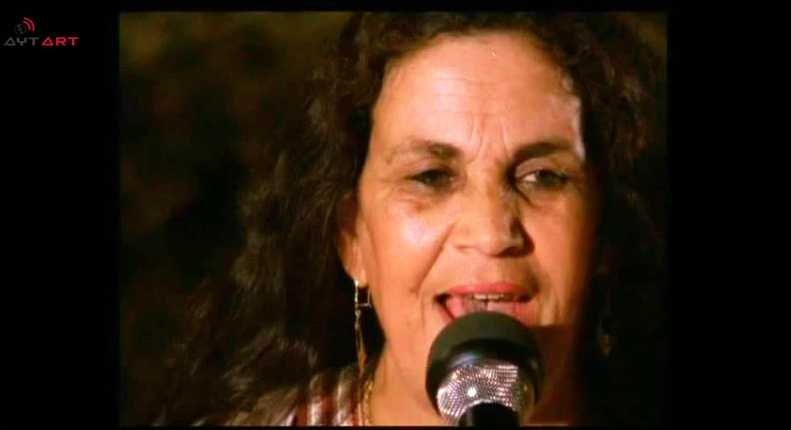A decade later, Fatna Bent Lhoucine moved to work with the Ouled Ben Aguida, a group of Aita, composed of Bouchaib L’kawmanjeh, Miloud , the violinist, Boujamaa, percussionist, along with Sheikhat Zineb M’sika, L’hathra and Souad L’baydawiya, Sheikha Hafeedah, Busheib’s wife, /Main Sheikha “Taba’a”. Fatna recorded over than 200 Aita songs with this group. Her first recordings were characterized by the fact that they included Aita in all its different styles. Fatna performed incredibly and proved that her crude and sharp rural voice is capable of delivering Aita Art in its real form. Her performance surpassed all expectations and shone as a Seikha “Taba’a”, although she was not as successful in singing Aita Hasawiya (more of urban style of Aita). This style requires a voice that is less rough and sharp. “Hajti Fi Grini” of the poet and Sheikha Kharboucha is one Fatna’s greatest performances. The legend performed hundreds of other Aita songs and became the Diva and the Queen of Aita.
Fatna Bent Lhoucine was born in the early 1930s in Sidi Benbour, Doukkala Abda, Morocco. Fatna has been influenced since her childhood by one of the most brilliant female artists of the time, Sheikha L’ghalia. The story began when Sheikha L’ghalia came to sing in one of the weddings in Sidi Bennour. L’ghalia was a unique woman with presence, charisma, deserved respect and pride. She was one of the rare women to drive a car at that time. This incident left a deep impression on Fatna Bent Lhoucine who then set herself the goal of becoming a sheikha like Sheikha L’ghalia. She then moved to the city of Yousoufiya after a short unsuccessful marriage experience. Fatna learned Aita from the big names like Sheikha Khadouj Laabdia and her husband Sheikh Mahjoub among others. These were her first steps toward making her image as a “Diva” and a legend of Aita.
Later on, the group began to re-arrange songs performed by Sintir (Gimbri), as well as other songs that belong to women’s groups in the rural area. For example Moulay Abdellah Tohami Salmi, which describes the rituals and way to Moulay Abdellah Amgar festival in the peripheries of the city of El Jadida city. The song Moulay Abdellah is much like Sayed Mekkawi’s song , in which he describes the birth of the prophet. Another example is the song “Chaiba Ya W’lidi” of Qarzouz and Mahrash, which tells the story of a young man named Chaiba who was arrested because of the amount of cannabis that was in his possession.
Despite some rearrangement and the use of new instruments like the violin and the lute, Sheikha Fatna Bent Lhoucine has preserved the pure rural authentic style in her songs which can be considered as a revival of Aita music and art.
Although the wide changes and the external influence on Aita, Sheikha Fatna Bent Lhoucine, thanks to her conspicuous presence and strong voice, was undoubtedly one of the last artists that the Aita Art is pround of.
If the early sheikhat and Shyoukh had the right to take pride in confronting the “makhzen” (Moroccan dictatorship) and French colonial authority, the legend Fatna Bent Lhoucine – proud of her rural identity and character of her unique voice- has the merit of reviving and established the pride of the rual identity. By registering and commemorating a large number of Aita songs, Fanta Bent Lhoucine deserves a historical legitimacy and the title of legend of Aita. She is as a reservoir of preserving the heritage and a model for Aita seasonal songs. Didn’t she said “Rani Sajjelt, La Tgoulo Mett” (artists never die).
Fatna Bent Lhoucine – Kharboucha ♪♪ فاطنة بنت الحسين – خربوشة


woow